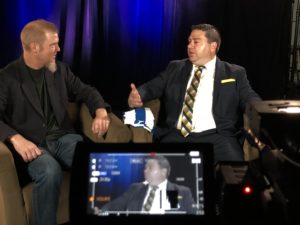This post originally appeared in the Blotch section of the Fort Worth Weekly's website. To consume it there : https://www.fwweekly.com/2018/04/04/sports-rush-stories-make-a-final-four-memorable/
The NCAA Basketball tournaments finished Monday: What will be their memorable Final Four storylines? The men’s side didn’t have closely contested games, but it did feature a compelling underdog in Loyola of Chicago and some outstanding players. The women’s side had no underdogs, as all four number seeds advanced from regional play. They made up for it with three dramatic finishes, included two semifinals decided in overtime and Notre Dame’s championship-winning buzzer beater Sunday night.
There will be a lot to remember from the weekend – stories that will stick in the minds of those who watched them unfold. Thursday, I got the chance to sit down with three men who had participated in six Final Fours between them, ones that have proven to have had lasting impacts. With this weekend’s stories from Columbus and San Antonio fresh in our minds, I thought I’d share some of the stories from the prequel I emceed in Dallas.
The event was billed as “Sidney, Sam & The Final Four,” and benefitted the charity programs of the National Basketball Retired Players Association’s local chapter. In addition to Sidney Moncrief and Sam Perkins, we added a special guest from the Houston chapter: Michael Young of Phi Slama Jama fame.
Perkins played in two Final Fours at the University of North Carolina. They lost to Isiah Thomas and Indiana his first season, but defeated Patrick Ewing and Georgetown in 1982 to win the title his sophomore year.
Moncrief teamed with Ron Brewer and Marvin Delph in the 1970s – they later became known as the Triplets – to get the University of Arkansas into the NCAA tournament for the first time since 1958. In Moncrief’s junior year, the Razorbacks went to the Final Four, something the team had not done since 1945, when only eight teams made the tournament.
Young went to three consecutive Final Fours with the University of Houston, teaming with the likes of Hakeem Olajuwon, Clyde Drexler, and Larry Micheaux to get to two championship games, including the 1983 game they lost to Jim Valvano’s North Carolina State team on a late Lorenzo Charles putback.
It’s always interesting to see what sticks out for participants years later. I led into the subject with Sam Perkins via an idea my father had broached when we were discussing the event. Dr. Olson wanted to know if Perkins remembered where he was standing when his teammate, a freshman named Michael Jordan, hit the jumper that ultimately proved a game-winner. It turns out Perkins wasn’t standing at all.
“I was on the court, so I wasn’t standing,” he said. “The shot goes up, you go to the boards, so I had somehow slipped in and tried to get the offensive rebound, but, of course, it went in.”
Young’s team lost to that UNC title team in the semis, then got back to the Final Four despite losing their leading scorer, Rob Williams, to the NBA. The sharpshooter remembered offseason preparation being key to his squad’s success.
“Once that year was over, we had a great summer together. Moses Malone took the team under his wing and we used to play down at a place called Fonde (Recreation Center). We would scrimmage against the guys from the Rockets every day, so every day was like a game situation . So that really prepared us for the next year coming up.”
At that point, one of the NBRPA members interrupted Young. Major Jones had played for the Rockets at the time and no doubt took part in some of those pickup games. Jones asked with a smile if playing those games was legal (it probably was). Legal or not, it would have been quite a scene to have been in the gym to watch Jones and company school (or sometimes be schooled by) the future NBA players on the Cougars roster at the time.
Moncrief’s group lost to eventual national champion Kentucky in the 1978 semis, but they still had to play another game because the NCAA staged a third-place game between the losing semifinalists until 1981.
“We played Notre Dame, and back then all the teams were very physical, nothing like you see now,” Moncrief recalled. “I just remember every player being so physically imposing. Every time I would go through the lane, they would just pop me and hit me and the game came down to a last-second shot. Ron Brewer, who’s one of the best players in the history of Arkansas basketball, he gets the ball at the top of the circle, five seconds left, he just cooly backed down, jumped up, turned around, and just made a beautiful shot to win the ballgame.”
The three each played for prominent coaches who left a lasting impression on their players.
“When we found ourselves back into the Final Four, we said we want to win this one for Coach Smith,” Perkins remembered. “It meant a great deal.” At the time, Dean Smith had cached the Tar Heels to six Finals Fours but had never won a title until Perkins, Jordan, and company helped the Hall of Famer secure his first.
All three men remembered their mentors’ impacts extending beyond the court. Young played for Guy V. Lewis. “He really got you prepared for the games and all of that stuff carried over into a lifestyle and a lot of his players that left his coaching and in his teaching, in the way that he did things, a lot of us guys went on to be successful.”
Of Lewis’s physical practices, Young remembered them as “unbelievable – no fouls.” It paid off for the team, though. “That got us ready for the games,” including, apparently the one against Perkins’ team in 1982.
“Sam was out there hacking,” Young suggested. “I know you don’t remember that, buddy. He did elbow me.” Perkins claimed a hazier memory of such conduct (the record does show Perkins as having been charged with a single personal foul in the game).
Moncrief also gave his college coach, Eddie Sutton, credit for later success. “It was love and discipline and it was a set of standards, being accountable to your teammates, to the classroom, to winning, that set the tone for my career. When I got to the NBA, I was so prepared to play at the next level simply because not only basketball, but just a discipline that we acquired by playing for Coach Sutton for four years. You had to do everything right, the right way, and he was tremendous coach. Just love him to death and he is the reason why I became a very good NBA player.”
The three players’ schools were in different situations when each played there, and the Final Four runs they made meant different things to each school.
In Moncrief’s case, the Razorbacks needed something to put them on the basketball map. His teams set the stage for the growth of the program.
“The key to having a good college program is recruiting. You win with players and I think once we started playing well, people wanted to be a part of the universe of Arkansas, so we got the best players in the state of Arkansas and we started getting some good players from outside of Arkansas and they created an environment that people wanted to be a part of.”
Young cited Phi Slama Jama’s style of play as one that not only inspired its nickname, but also helped the Cougars bring in the players they needed.
“We got up and down the court and we would have bets as players who would have the most dunks,” he recalled. “The other kids that the coaches were recruiting, they really liked that.”
Houston’s program had enjoyed success prior to Young’s time, especially the Elvin Hayes-led teams of the 1960s, but not at the level of tradition-rich North Carolina. For Perkins, the Final Four runs embodied the approach of the coach who had built the program around the important things. “I think the NBA looked at that as you being prepared being fundamentally prepared to to play the game.” One can be sure that if a program does things that influence the NBA to consider players as draftable, that’s a powerful recruiting tool, too. The Tar Heels have played in ten more Final Fours since Perkins’ heyday, and have had 58 players drafted since he was a freshman (including Perkins himself, fourth overall to the Dallas Mavericks in 1984).
We also discussed the impact of the three-pointer on basketball. It was not widespread in the college game when they played, with only Perkins having shot any threes at all during his university days, and that during a one-year experiment by the Atlantic Coast Conference. He said got a lot of those as a trailer on fast breaks, foreshadowing his future success as a pioneering stretch-four. Michael Young speculated he’d have averaged “at least ten more” points a game if his long-range swishes had counted for an extra point. Moncrief thinks it could have made all the difference for his Razorbacks.
“We would have won the NCAA tournament with a three-point shot, not because of me, but we had two of the greatest shooters. Marvin Delph and Ron Brewer could shoot the basketball as well as any players that I’ve seen on a team, so we would have no doubt been a better team with a three.”
We archived a video of the entire session online, if you want to hear Perkins and Jordan’s tales about Michael Jordan or how all three men stayed in school for four years. All the stories were superb, and I look forward to a time when we’ll hear memorable ones from the participants in this year’s tournament.
Rush Olson has spent more than two decades directing creative efforts for sports teams and broadcasters. He currently creates ad campaigns, television programs, and related creative projects for sports entities through Rush Olson Creative & Sports, Mint Farm Films, and FourNine Productions.






